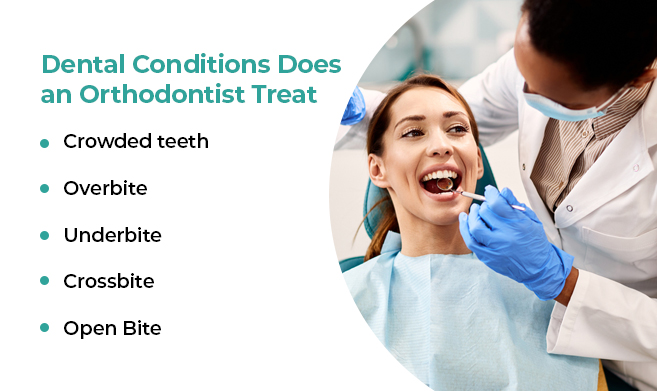The Basic Principles Of Legacy Orthodontics
The Basic Principles Of Legacy Orthodontics
Blog Article
Getting My Legacy Orthodontics To Work
Table of ContentsFacts About Legacy Orthodontics RevealedUnknown Facts About Legacy OrthodonticsNot known Facts About Legacy OrthodonticsThe Definitive Guide to Legacy OrthodonticsHow Legacy Orthodontics can Save You Time, Stress, and Money.
In addition, we supply flexible treatment timetables, versatile payment options and a fun, delightful experience.An orthodontist is a dental expert trained to detect, prevent, and deal with teeth and jaw irregularities. Orthodontists function with people of all ages, from children to grownups.
Malocclusion, or misaligned teeth, can result in dental issues, consisting of dental cavity, gum tissue illness, and hard or unpleasant eating. Not every person is birthed with straight teeth. If you have a negative bite or large rooms between your teeth, you might wish to get in touch with a dental expert concentrating on orthodontic care.
The smart Trick of Legacy Orthodontics That Nobody is Talking About
( Photo Credit Scores: DigitalVision/Getty Images) Orthodontists use taken care of and detachable oral tools, like dental braces, retainers, and bands, to transform the setting of teeth in your mouth. Orthodontic therapy is for oral abnormalities, including: Misaligned teethBite issues, like an overbite or an underbiteCrowded teeth or teeth that are also far apartJaw misalignmentThe objective of orthodontic treatment is to improve your bite.
A healthy and balanced bite guarantees you can eat, eat, and talk effectively. While you could think about orthodontists as mainly for youngsters or teenagers that need braces, they can remedy oral troubles at any age. Orthodontists participate in college, dental school, and orthodontic college. After college graduation, they spend 2 or 3 years in an orthodontic residency program.
All orthodontists are dentists, but not all dental practitioners are orthodontists. Orthodontic residency programs supply intensive, concentrated instruction for dental specialists. They concentrate on two areas: Just how to appropriately and safely relocate teeth Just how to properly lead development in the teeth, jaw, and faceOnce an orthodontist has finished training, they have the alternative to come to be board licensed.
Legacy Orthodontics Fundamentals Explained
Misalignment, or malocclusion, is the most typical reason people see an orthodontist. It is genetic and is the result of dimension distinctions in between the upper and lower jaw or between the jaw and teeth. Malocclusion results in tooth overcrowding, a misshapen jaw, or irregular bite patterns. Malocclusion is generally treated with: Your orthodontist connects metal, ceramic, or plastic square bonds to your teeth.
Some individuals need a headwear to assist move teeth into line with pressure from outside the mouth. A retainer is a custom device that maintains your teeth in location.
They can create extra room in the mouth without having to draw teeth. Orthodontists use cords, medical screws, or plates to sustain your jaw bone.
You may need to see an orthodontist if you have: Crowding or not adequate area for all of your teethOverbite, when your top teeth come by your base teethUnderbite, when your base teeth are also much forwardSpacing or concerns with gapsCrossbite, which is when your upper teeth fit behind your bottom teeth when your mouth is closedOpen bite or an upright void in between your front base and top teethMisplaced midline, when the facility of your base and upper teeth don't line up Dealing with an oral malocclusion can: Make biting, chewing, and talking easierImprove the proportion of our face and your general appearanceEase discomfort from temporomandibular joint disordersSeparate your teeth and make them less complicated to cleanse, helping prevent dental caries or tooth cavities It's usually a dental expert who first notifications misaligned teeth throughout a routine test.
Legacy Orthodontics - Questions

During your initial orthodontic examination, you'll likely have: A dental examPhotos taken of your face and smileDental X-raysPanoramic (360 degree) X-rays of your face and headImpressions to produce mold and mildews of your teethThese examinations will help your orthodontist understand how to continue with your therapy. orthodontist. An orthodontist is a dental expert that's had training to treat your teeth and jaw
Orthodontists may do surgery, exams,X-rays,and even more to assist you obtain a much more comfortable, healthier smile. An orthodontist is concentrated on your bite, so something like a broken tooth would be handled by a dental professional. Orthodontists are dental experts but not all dental professionals are orthodontists. Orthodontists are focused on your bite, or the way your teeth fit together, and the straightness of your teeth.
Ever questioned exactly how celebrities always seem to have perfectly straightened teeth? The response usually exists in the proficient hands of an orthodontist. Yet exactly what does an orthodontist do? Orthodontists are oral professionals that concentrate on correcting irregularities in the teeth and jaws. Their knowledge surpasses just creating a beautiful smile; it includes boosting your general dental wellness and feature.
The 5-Second Trick For Legacy Orthodontics

, orthodontists have a diverse toolkit at their disposal. These reliable braces use a system of braces adhered to the teeth and attached by cords.
Clear aligners, like Invisalign, are a prominent choice special info for individuals looking for a much more discreet therapy alternative. These detachable trays are customized to gradually move the teeth's setting. Headwear may be used together with dental braces or aligners to use additional targeted pressures, specifically for fixing jaw disparities. In instances of narrow jaws, palatal expanders can be used to produce space for appropriate tooth placement.
Report this page